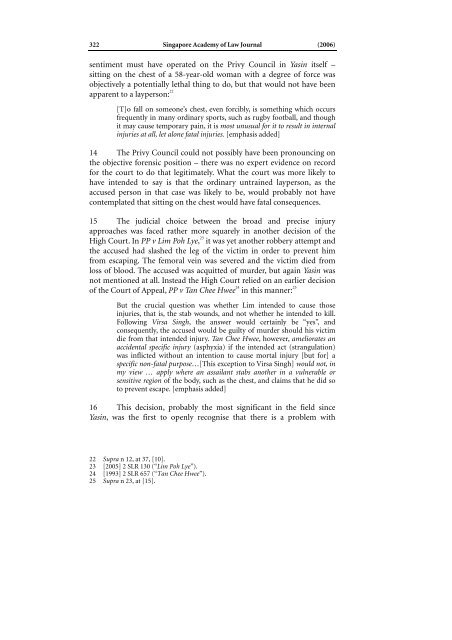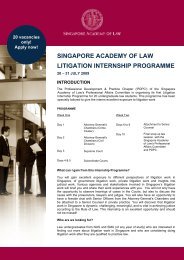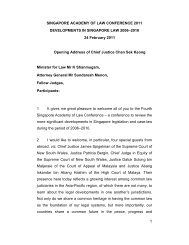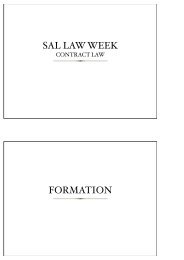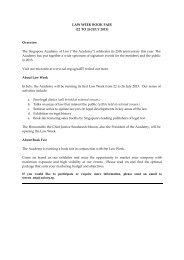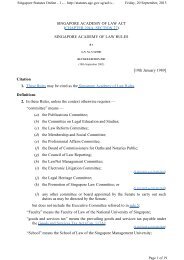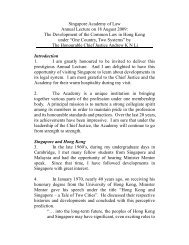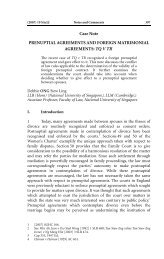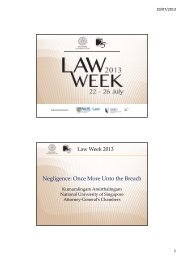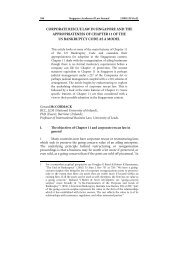2. Managing Mens Rea in Singapore - Singapore Academy of Law
2. Managing Mens Rea in Singapore - Singapore Academy of Law
2. Managing Mens Rea in Singapore - Singapore Academy of Law
Create successful ePaper yourself
Turn your PDF publications into a flip-book with our unique Google optimized e-Paper software.
322S<strong>in</strong>gapore <strong>Academy</strong> <strong>of</strong> <strong>Law</strong> Journal (2006)sentiment must have operated on the Privy Council <strong>in</strong> Yas<strong>in</strong> itself –sitt<strong>in</strong>g on the chest <strong>of</strong> a 58-year-old woman with a degree <strong>of</strong> force wasobjectively a potentially lethal th<strong>in</strong>g to do, but that would not have beenapparent to a layperson: 22[T]o fall on someone’s chest, even forcibly, is someth<strong>in</strong>g which occursfrequently <strong>in</strong> many ord<strong>in</strong>ary sports, such as rugby football, and thoughit may cause temporary pa<strong>in</strong>, it is most unusual for it to result <strong>in</strong> <strong>in</strong>ternal<strong>in</strong>juries at all, let alone fatal <strong>in</strong>juries. [emphasis added]14 The Privy Council could not possibly have been pronounc<strong>in</strong>g onthe objective forensic position – there was no expert evidence on recordfor the court to do that legitimately. What the court was more likely tohave <strong>in</strong>tended to say is that the ord<strong>in</strong>ary untra<strong>in</strong>ed layperson, as theaccused person <strong>in</strong> that case was likely to be, would probably not havecontemplated that sitt<strong>in</strong>g on the chest would have fatal consequences.15 The judicial choice between the broad and precise <strong>in</strong>juryapproaches was faced rather more squarely <strong>in</strong> another decision <strong>of</strong> theHigh Court. In PP v Lim Poh Lye, 23 it was yet another robbery attempt andthe accused had slashed the leg <strong>of</strong> the victim <strong>in</strong> order to prevent himfrom escap<strong>in</strong>g. The femoral ve<strong>in</strong> was severed and the victim died fromloss <strong>of</strong> blood. The accused was acquitted <strong>of</strong> murder, but aga<strong>in</strong> Yas<strong>in</strong> wasnot mentioned at all. Instead the High Court relied on an earlier decision<strong>of</strong> the Court <strong>of</strong> Appeal, PP v Tan Chee Hwee 24 <strong>in</strong> this manner: 25But the crucial question was whether Lim <strong>in</strong>tended to cause those<strong>in</strong>juries, that is, the stab wounds, and not whether he <strong>in</strong>tended to kill.Follow<strong>in</strong>g Virsa S<strong>in</strong>gh, the answer would certa<strong>in</strong>ly be “yes”, andconsequently, the accused would be guilty <strong>of</strong> murder should his victimdie from that <strong>in</strong>tended <strong>in</strong>jury. Tan Chee Hwee, however, ameliorates anaccidental specific <strong>in</strong>jury (asphyxia) if the <strong>in</strong>tended act (strangulation)was <strong>in</strong>flicted without an <strong>in</strong>tention to cause mortal <strong>in</strong>jury [but for] aspecific non-fatal purpose…[This exception to Virsa S<strong>in</strong>gh] would not, <strong>in</strong>my view … apply where an assailant stabs another <strong>in</strong> a vulnerable orsensitive region <strong>of</strong> the body, such as the chest, and claims that he did soto prevent escape. [emphasis added]16 This decision, probably the most significant <strong>in</strong> the field s<strong>in</strong>ceYas<strong>in</strong>, was the first to openly recognise that there is a problem with22 Supra n 12, at 37, [10].23 [2005] 2 SLR 130 (“Lim Poh Lye”).24 [1993] 2 SLR 657 (“Tan Chee Hwee”).25 Supra n 23, at [15].


